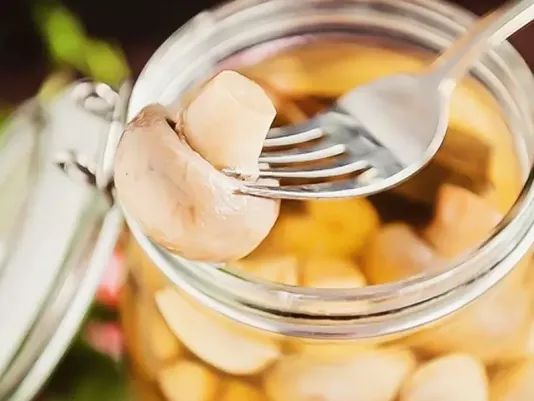Shish Kebab in the Oven
Shish kebab in the oven - a recipe for Georgian cuisine, it turns out that shish kebab can be cooked at home in the oven.

Pickled Champignons are one of those ingredients that always save the moment. I often use them when I need to quickly assemble a snack or complement a main dish with something vivid and expressive. Over the years of cooking, I’ve learned to judge their quality at first glance: the color should be even, without a gray hue, the caps intact, and the brine clear and fragrant. It’s important that the mushrooms aren’t too soft or slimy – that signals improper pickling. Pickled champignons are not only convenient but also highly versatile: they pair beautifully with meat, herbs, grains, and even eggs or hard cheese. I always emphasize that the true value of this product lies in its consistency – the taste, texture, and aroma remain predictable even after long storage, as long as the brine proportions and jar sterility are maintained.
I always start by inspecting the jar carefully: clear glass allows you to assess both the brine and the mushrooms themselves. Good pickled champignons have a light, almost creamy color; their caps hold shape, and stems remain attached. The brine should be transparent or slightly tinted with spices, but never cloudy. Through years of cooking, I’ve found that too much vinegar easily overwhelms the natural aroma, so I choose those with a balanced composition – water, vinegar, salt, sugar, a bit of bay leaf, black pepper, and clove. If preservatives or colorants are listed, I skip that purchase – true quality needs no chemicals. For homemade preserves, I always use small young champignons – they keep their shape better. Large ones often become watery and lose texture. Another tip is to check the smell after opening: a light vinegar aroma is normal, but a sharp or musty scent indicates improper processing or storage. If the mushroom feels unusually soft or slimy, it’s better not to eat it, even if the taste seems fine.
Before adding champignons to a dish, I always assess how sour or salty they are. If the pickle is too intense, it’s best to drain part of the brine and rinse the mushrooms under cold water to soften the taste. For salads or hot appetizers, I let them drain in a sieve so excess moisture doesn’t dilute other ingredients. When preparing side dishes or fillings, I like to sauté pickled champignons in a dry pan for a few minutes to enhance their aroma and evaporate leftover brine. In my experience, after brief heating they blend better with creamy sauces or eggs. For cold dishes, it’s important to let them sit at room temperature for at least 15 minutes – straight-from-the-fridge cold dulls the flavor. For festive dishes, I might drizzle them lightly with oil, lemon juice, and a pinch of sugar – it balances the acidity and adds shine. These are small details, but they define how balanced the final result will be.
Pickled champignons are ready to eat, but they require gentle handling when cooked. They shouldn’t be overfried: under excessive heat, they quickly lose shape and become fibrous. On medium heat, they retain juiciness and gentle firmness, and when warmed with oil or onions, they develop a pleasant nutty note. I’ve noticed many times that even brief heating changes the aroma balance – the mushroom becomes deeper, revealing natural sweetness. When using them in casseroles or pizza, I add them at the final stage, when the base is nearly done. In hot dishes, it’s important to ensure the mushrooms don’t sit in liquid – this keeps them from getting soggy. Another practical tip – don’t cover them until evenly heated: steam makes them too soft. For salads, I never use warm mushrooms, since the temperature contrast with greens or cheese can spoil the texture.
Pickled champignons pair wonderfully with both creamy and sweet-and-sour flavors. In my experience, they shine best with a sour cream–mustard sauce or a light oil dressing with lemon juice. They complement meats – especially veal, turkey, or roasted pork – and go well with grains like buckwheat, bulgur, and rice. I add herbs moderately: parsley or dill enhance freshness, while basil or oregano can overpower the mushroom aroma. The most fitting spices are black pepper, allspice, and a touch of coriander. To create a more complex flavor, I add a few drops of white wine while warming them – it deepens the taste without making the dish sour. Saltiness also matters: if the pickle is already rich, other components should be minimally salted. Over the years, I’ve found that the best combinations are always simple yet balanced – when no ingredient competes for attention but complements the rest.
The most frequent mistake is ignoring expiration dates. Even sterilized mushrooms aren’t eternal, so I always check the production date and lid condition – any swelling means don’t open it. Another mistake is improper storage after opening. I always keep the jar of pickled champignons in the refrigerator, tightly sealed, and use it within a week. If the champignons have been heated, I never return them to the brine – it increases the risk of spoilage. Another point: never mix pickled champignons from different batches, even if they look similar, because acidity and spices may vary. I’ve seen entire dishes ruined by such details. Also, don’t rely solely on appearance – even beautiful champignons can be over-pickled, which shows as bitterness. To test, taste just one – a quality product has a bright, clean flavor without off-notes. I always follow this principle and have never had problems with spoiled champignons.